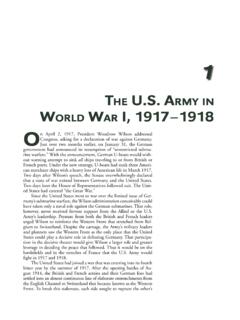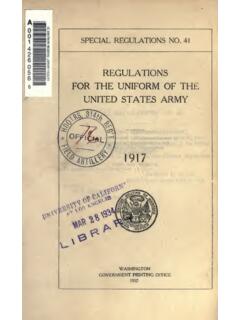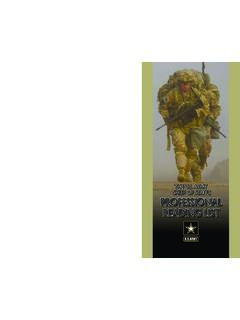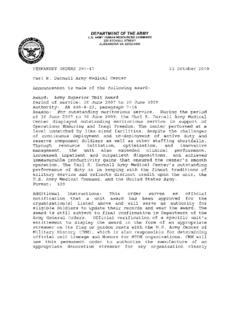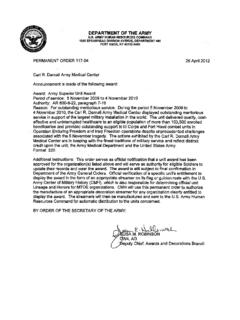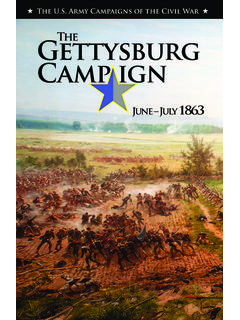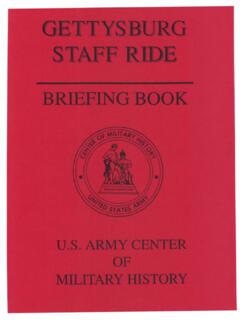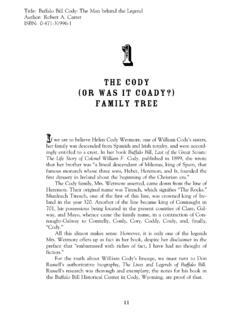Transcription of R. Cody Phillips Michael D. Krause and
1 Historical PersPectivesof tHe oPerational artMichael D. Krause and R. Cody PhillipsCenter of Military HistoryUnited States ArmyHistorical PersPectives of tHe oP erational artMichael D. Krause and R. Cody Phillips Center of Military History, United States ArmyHistorical PersPectivesoP erational artPIN: 081038 000 vPrefaceHistorical Perspectives of the Operational Art is a unique study in the field of military history. relying on the expertise of scholars and military historians from the United states, Great Britain, and Germany, it highlights some of the significant developments in the modern evolution of the operational level of war. our intention was not to include every major military power in recent history and certainly not every conflict.
2 Yet students of the operational art may want to look at past wars to see how this added dimension of armed conflict might have surfaced or been applied. this study deals only with land warfare and is designed to show the doctrinal development and application of operational art in modern history. thus, while the British, chinese, and Japanese clearly demonstrated techniques associated with the operational art of war, their experiences tended to parallel practices already developed and implemented art has its origins in Western europe. Beginning with the skillful adaptations of napoleon Bonaparte, military commanders began to recognize the middle ground that linked national strategic goals with tactical objectives on the battlefield.
3 The Germans, following the example of field Marshal Helmuth von Moltke, devised the initial concepts about the operational art of war, while french contemporaries wrestled with devising a satisfactory doctrine of their own. the russians and soviets learned from their military brethren in Western europe and also developed a vibrant doctrine that was masterfully implemented during the latter half of World War ii. the United states, in contrast, entered the field of study belatedly. although there clearly were moments when the operational art could be observed in selected campaigns, it is apparent that the army s doctrinal development of this connection between strategy and tactics progressed in an irregular manner and reached fruition only recently most notably in operations Desert shielD and Desert , operations, and tactics routinely affect the dimensions of military conflict, each in a different manner.
4 For instance, the strategist aims at the enemy center of gravity, which often is the nation s will to fight, or perhaps the key resources or the delicate bond that holds an alliance together. the operational artist s center of gravity is the mass of the enemy s military force and its ability to command and control its forces. at the tactical level, the battlefield commander has a more limited and proximate perspective and focuses on his immediate foe. strategy may dictate whether or not to fight, but operations will determine Historical PersPectives of tHe oPerational artMichael D. Krause andR. Cody PhillipsGeneral editorscenter of Military HistoryUnited states armyWashington, , 2005iiiLibrary of Congress Cataloging-in-Publication DatacMH Pub 70 89 1forewordas we begin a new millennium and witness the rapid and complex changes happening around the world, the study of the operational art of war becomes even more critical.
5 Today our army is facing a multitude of challenges ranging from disaster relief and peacekeeping operations to open hostilities and war. to keep pace with both those demands and the growth of new technologies, we are currently transforming our service from a primarily heavy, forward-deployed force to a lighter, more agile, but also more deadly conUs-based one. at the same time, the scope of our operations and our strategy is becoming increasingly influenced by our participation in international coalitions and alliances. the time-honored focus of operational art on the planning and execution of military campaigns has thus become even more diverse and complex, placing great demands on the military professional. although operational art must be adjusted to accommodate these changing circumstances, it should not be done without some understanding a frame of reference of the history of the operational level of war so as to clarify the nature of the problems we can expect in the Perspectives of the Operational Art is an anthology of essays by historians and scholars who trace the origin and development of the operational level of warfare, the critical link between strategy and tactics.
6 Col. Michael D. Krause , former deputy commander of the army center of Military History, made the initial selections for this anthology. as a student of the subject and instructor at the national War college, colonel Krause was well qualified for the task. this volume may be regarded as a continuation of an earlier publication that he coedited on a similar subject, On Operational Art, which is a collection of pieces by senior military commanders and theorists dealing with the contemporary application of the operational art of war. for the soldier and student alike, Historical Perspectives of the Operational Art should stimulate thought and provide a deeper understanding of military history and its ability to shed light on the problems and challenges of the , JoHn s.
7 BroWn17 May 2005 Brigadier General, Usa (ret.) chief of Military HistoryHistorical perspectives of the operational art / Michael D. Krause and r. cody Phillips , general editors. p. cm. includes bibliographical references. 1. operational art (Military science) History. i. Krause , Michael D. (MichaelDetlef), 1942 ii . Phillips , r. 09 dc222004057948iiiLibrary of Congress Cataloging-in-Publication DatacMH Pub 70 89 1forewordas we begin a new millennium and witness the rapid and complex changes happening around the world, the study of the operational art of war becomes even more critical. today our army is facing a multitude of challenges ranging from disaster relief and peacekeeping operations to open hostilities and war. to keep pace with both those demands and the growth of new technologies, we are currently transforming our service from a primarily heavy, forward-deployed force to a lighter, more agile, but also more deadly conUs-based one.
8 At the same time, the scope of our operations and our strategy is becoming increasingly influenced by our participation in international coalitions and alliances. the time-honored focus of operational art on the planning and execution of military campaigns has thus become even more diverse and complex, placing great demands on the military professional. although operational art must be adjusted to accommodate these changing circumstances, it should not be done without some understanding a frame of reference of the history of the operational level of war so as to clarify the nature of the problems we can expect in the Perspectives of the Operational Art is an anthology of essays by historians and scholars who trace the origin and development of the operational level of warfare, the critical link between strategy and tactics.
9 Col. Michael D. Krause , former deputy commander of the army center of Military History, made the initial selections for this anthology. as a student of the subject and instructor at the national War college, colonel Krause was well qualified for the task. this volume may be regarded as a continuation of an earlier publication that he coedited on a similar subject, On Operational Art, which is a collection of pieces by senior military commanders and theorists dealing with the contemporary application of the operational art of war. for the soldier and student alike, Historical Perspectives of the Operational Art should stimulate thought and provide a deeper understanding of military history and its ability to shed light on the problems and challenges of the , JoHn s.
10 BroWn17 May 2005 Brigadier General, Usa (ret.) chief of Military HistoryHistorical perspectives of the operational art / Michael D. Krause and r. cody Phillips , general editors. p. cm. includes bibliographical references. 1. operational art (Military science) History. i. Krause , Michael D. (MichaelDetlef), 1942 ii . Phillips , r. 09 dc222004057948vPrefaceHistorical Perspectives of the Operational Art is a unique study in the field of military history. relying on the expertise of scholars and military historians from the United states, Great Britain, and Germany, it highlights some of the significant developments in the modern evolution of the operational level of war. our intention was not to include every major military power in recent history and certainly not every conflict.
